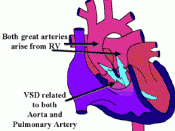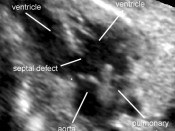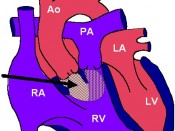What is Double Outlet Right Ventricle (DORV)?
 Double outlet right ventricle (DORV) is a form of congenital heart disease where both of the great arteries connect (in whole or in part) to the right ventricle (RV). In double outlet right ventricle (DORV) the aorta rises from the right ventricle (the chamber of the heart that pumps blood to the lungs), instead of from the left ventricle (the normal pumpng chamber to the body). Both the pulmonary artery (which carries oxygen-poor blood to the lungs) and aorta (which carries oxygen-rich blood from the heart to the body) come from the same pumping chamber. No arteries arise from the left ventricle (the normal pumping chamber to the body).
Double outlet right ventricle (DORV) is a form of congenital heart disease where both of the great arteries connect (in whole or in part) to the right ventricle (RV). In double outlet right ventricle (DORV) the aorta rises from the right ventricle (the chamber of the heart that pumps blood to the lungs), instead of from the left ventricle (the normal pumpng chamber to the body). Both the pulmonary artery (which carries oxygen-poor blood to the lungs) and aorta (which carries oxygen-rich blood from the heart to the body) come from the same pumping chamber. No arteries arise from the left ventricle (the normal pumping chamber to the body).
There are several types of DORV. The difference between types is the location of the VSD compared to the location of the pulmonary artery and aorta. The type of DORV, and the presence or absence of pulmonary valve stenosis, affect the severity of signs and symptoms the baby may have.
Causes of Double Outlet Right Ventricle
 Normally, the aorta arises from the left ventricle (the chamber of the heart that usually pumps blood to the body). The pulmonary artery normally arises from the right ventricle. In DORV, both arteries arise from the right ventricle. This is a problem because the right ventricle carries oxygen-poor blood, which the aorta then carries throughout the body. DORV always includes a ventricular septal defect (VSD). Pulmonary valve stenosis or transposition of the great arteries may also be part of the defect.
Normally, the aorta arises from the left ventricle (the chamber of the heart that usually pumps blood to the body). The pulmonary artery normally arises from the right ventricle. In DORV, both arteries arise from the right ventricle. This is a problem because the right ventricle carries oxygen-poor blood, which the aorta then carries throughout the body. DORV always includes a ventricular septal defect (VSD). Pulmonary valve stenosis or transposition of the great arteries may also be part of the defect.
The presence of a VSD helps the infant with DORV, because oxygen-rich blood from the lungs flows from the left side of the heart, through the VSD opening and into the right chamber, mixing with the oxygen-poor blood. However, the body may still not get enough oxygen even with this mixture, and the heart has to work harder to try to bring more oxygen-rich blood to the body. In addition, because the pulmonary artery receives blood from both ventricles instead of just the right one, blood pressure in the lungs increases. Patients with DORV often have other heart abnormalities such as:
•Anomalous coronary arteries
•Coarctation of the aorta
•Mitral valve problems
•Pulmonary atresia
•Pulmonary valve stenosis
•Right aortic arch
•Transposition of the great arteries
Symptoms of Double Outlet Right Ventricle
•Baby tires easily, especially when feeding
•Bluish skin color (the lips may also be blue)
•Clubbing (thickening of the nail beds) on toes and fingers (late sign)
•Failure to gain weight and grow
•Pale coloring
•Sweating
•Swollen legs or abdomen
•Trouble breathing
•Enlarged heart
•Heart murmur
•Rapid breathing
•Rapid heartbeat
Exams and Tests for Double Outlet Right Ventricle
•Chest x-rays
•Passing a thin, flexible tube into the heart to measure blood pressure and inject dye for special pictures of the heart and arteries (cardiac catheterization)
•Ultrasound exam of the heart (echocardiogram)
•Using magnets to create images of the heart (MRI)
Treatment of Double Outlet Right Ventricle
Treatment requires surgery to close the holes in the heart. Surgery may also be needed to fix other existing problems in the heart. Several factors determine the type and number of operations the baby may need, including:
•The type of DORV
•The severity of the defect
•The presence of other problems in the heart
•The child’s overall condition
If pulmonary stenosis is not present, double outlet right ventricle may be repaired in one operation. The surgeon will repair the VSD, but build a conduit through it to connect the left ventricle to the aorta. This technique is known as the Rastelli procedure. Other surgeons may opt for the arterial switch operation  (or Jatene), commonly also used with transposition of the great arteries, in which the aorta is reconnected to the left ventricle. The surgical technique will depend upon the several factors: the location of the VSD and its relationship to the aortic and pulmonary valves, the presence or absence of pulmonary stenosis, and the distribution of the coronary arteries. There are also factors such as A-V discordance, size of the right ventricle, and the straddling of A-V valves.
(or Jatene), commonly also used with transposition of the great arteries, in which the aorta is reconnected to the left ventricle. The surgical technique will depend upon the several factors: the location of the VSD and its relationship to the aortic and pulmonary valves, the presence or absence of pulmonary stenosis, and the distribution of the coronary arteries. There are also factors such as A-V discordance, size of the right ventricle, and the straddling of A-V valves.
Outlook (Prognosis) of Double Outlet Right Ventricle
How well the baby does depends on several factors, including:
•The size of the VSD
•Its location
•The size of the pumping chambers
•The location of the aorta and pulmonary artery
•The presence of additional complications (such as coarctation of the aorta and mitral valve problems)
•The baby’s overall health at the time of diagnosis
•Whether irreversible lung damage has occurred
Possible Complications of Double Outlet Right Ventricle
•Congestive heart failure (CHF)
•High blood pressure in the lungs
•Irreversible damage to the lungs due to untreated high blood pressure in the lungs
•All children with this congenital heart disease should take antibiotics before dental treatment to prevent infections of the heart.
When to Contact a Medical Professional about the posibility of Double Outlet Right Ventricle
Call your health care provider if your child seems to tire easily, has trouble breathing, or has bluish skin or lips. You should also consult your health care provider if your baby is not growing or gaining weight.
Alternative Names for Double Outlet Right Ventricle
DORV; Taussig-Bing anomaly; DORV with doubly-committed VSD; DORV with noncommitted VSD; DORV with subaortic VSD

